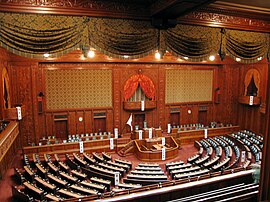
Back مجلس النواب الياباني Arabic Cámara de representantes de Xapón AST Yaponiya parlamentinin Nümayəndələr Palatası Azerbaijani Cambra de Representants del Japó Catalan ئەنجومەنی نوێنەران (ژاپۆن) CKB Shūgiin German Βουλή των Αντιπροσώπων (Ιαπωνία) Greek Ŝugiin Esperanto Cámara de Representantes de Japón Spanish مجلس نمایندگان (ژاپن) Persian
House of Representatives 衆議院 Shūgiin | |
|---|---|
| 215th Session of the National Diet | |
 | |
| Type | |
| Type | of the National Diet |
| Leadership | |
| Structure | |
| Seats | 465 |
 | |
Political groups | Government (220)
Opposition (241) Unaffiliated (4)
|
| Committees | 17 committees |
Length of term | Up to 4 years |
| Salary | Speaker: ¥2,170,000/m Vice Speaker: ¥1,584,000/m Members: ¥1,294,000/m |
| Elections | |
| Parallel voting: First-past-the-post voting (289 seats) Party-list proportional representation (176 seats) | |
First election | 1 July 1890 |
Last election | 27 October 2024 |
Next election | No later than 22 October 2028 |
| Meeting place | |
 | |
| Chamber of the House of Representatives | |
| Website | |
| www | |
| This article is part of a series on |
 |
|---|
|
|
The House of Representatives (Japanese: 衆議院, Hepburn: Shūgiin) is the lower house of the National Diet of Japan. The House of Councillors is the upper house. The composition of the House is established by Article 41 and Article 42 of the Constitution of Japan.[1] The House of Representatives has 465 members, elected for a four-year term. Of these, 176 members are elected from 11 multi-member constituencies by a party-list system of proportional representation, and 289 are elected from single-member constituencies.
The overall voting system used to elect the House of Representatives is a parallel system, a form of semi-proportional representation. Under a parallel system, the allocation of list seats does not take into account the outcome in the single seat constituencies. Therefore, the overall allocation of seats in the House of Representatives is not proportional, to the advantage of larger parties. In contrast, in bodies such as the German Bundestag or the New Zealand Parliament the election of single-seat members and party list members is linked, so that the overall result respects proportional representation fully or to some degree.[citation needed]
The House of Representatives is the more powerful of the two houses, able to override vetoes on bills imposed by the House of Councillors with a two-thirds majority.[2][3][4]
The last election for the House of Representatives was held on October 27, 2024, in which the Liberal Democratic Party and their coalition partner Komeito failed to reach a majority of 233 seats, instead winning 215, 18 short of a majority.
Cite error: There are <ref group=lower-alpha> tags or {{efn}} templates on this page, but the references will not show without a {{reflist|group=lower-alpha}} template or {{notelist}} template (see the help page).
- ^ "The Constitution of Japan". Japanese Law Translation. Archived from the original on January 5, 2021. Retrieved August 7, 2020.
- ^ "Japan election: PM Shinzo Abe dissolves parliament". BBC News. September 28, 2017. Archived from the original on December 1, 2021. Retrieved July 21, 2018.
- ^ Takenaka, Linda Sieg (September 28, 2017). "Japan calls snap election as new party roils outlook". Reuters. Archived from the original on September 28, 2017. Retrieved September 28, 2017.
- ^ "Democratic Party effectively disbands, throwing support behind Koike's party for Lower House poll". September 28, 2017. Archived from the original on September 28, 2017. Retrieved September 28, 2017.